Palaeo-Tsunami Events on the Coasts of Cyprus
Abstract
:1. Introduction
2. The Geotectonic Setting of Cyprus
3. Historic Record of Tsunamis in Cyprus
4. Evidence of Palaeo-Tsunamis on the Coastal Zone of Cyprus
4.1. An Overview of Published Field Evidence
4.2. Survey Overview of Available Field Data
4.3. An Overview of New Field Data
5. Warning System and Tsunami Risk for Cyprus Coasts
- Local, strong, submarine and surface earthquakes in the central part of the Cyprus arc (e.g., the earthquakes of 1222 and 1953). The Cyprian arc is subjected to subduction, collision, and transcurrent tectonic processes.
- Submarine landslides on the Levantine coast, which are caused by strong earthquakes in the rift of the Dead Sea (e.g., the earthquake of 1202). Near the Levantine coast, the bottom is characterized by a steep slope, as well as east of Rhodes Island and south of the Cypriot shoreline, south from Paphos city.
- Regional, strong, submarine and surface earthquakes in the Hellenic arc (e.g., the earthquakes of 1303 and 365). The tsunami potential in the Hellenic arc is the highest in the Mediterranean.
6. Concluding Remarks
Supplementary Materials
Author Contributions
Funding
Data Availability Statement
Acknowledgments
Conflicts of Interest
References
- Jankaew, K.; Atwater, B.F.; Sawai, Y.; Choowong, M.; Charoentitirat, T.; Martin, M.E.; Prendergast, A. Medieval forewarning of the 2004 Indian Ocean tsunami in Thailand. Nature 2008, 455, 1228–1231. [Google Scholar] [CrossRef]
- Horton, B.P.; Rossi, V.; Hawkes, A.D. The sedimentary record of the 2005 hurricane season from the Mississippi and Alabama coastlines. Quat. Int. 2009, 195, 15–30. [Google Scholar] [CrossRef]
- Liu, W.; Yamazaki, F.; Gokon, H.; Koshimura, S. Extraction of Tsunami-Flooded Areas and Damaged Buildings in the 2011 Tohoku-Oki Earthquake from TerraSAR-X Intensity Images. Earthq. Spectra 2013, 29, 183–200. [Google Scholar] [CrossRef] [Green Version]
- Dawson, A.; Shi, S. Tsunami Deposits. Pure Appl. Geophys. 2000, 157, 875–897. [Google Scholar] [CrossRef]
- Gelfenbaum, G.; Jaffe, B. Erosion and Sedimentation from the 17 July, 1998 Papua New Guinea Tsunami. Pure Appl. Geophys. 2003, 160, 1969–1999. [Google Scholar] [CrossRef]
- Scheffers, A.; Kelletat, D. Sedimentologic and geomorphologic tsunami imprints worldwide—A review. Earth-Sci. Rev. 2003, 63, 83–92. [Google Scholar] [CrossRef]
- Goff, J.; Chagué-Goff, C.; Nichol, S.; Jaffe, B.; Dominey-Howes, D. Progress in palaeotsunami research. Sediment. Geol. 2012, 243–244, 70–88. [Google Scholar] [CrossRef]
- England, P.; Howell, A.; Jackson, J.; Synolakis, C. Palaeotsunamis and tsunami hazards in the Eastern Mediterranean. Philos. Trans. R. Soc. A Math. Phys. Eng. Sci. 2015, 373, 20140374. [Google Scholar] [CrossRef] [Green Version]
- Marriner, N.; Kaniewski, D.; Morhange, C.; Flaux, C.; Giaime, M.; Vacchi, M.; Goff, J. Tsunamis in the geological record: Making waves with a cautionary tale from the Mediterranean. Sci. Adv. 2017, 3, e1700485. [Google Scholar] [CrossRef] [Green Version]
- Sugawara, D. Lessons from the 2011 Tohoku-oki tsunami: Implications for Paleotsunami research. In Tsunamiites; Elsevier: Amsterdam, The Netherlands, 2021; pp. 155–181. [Google Scholar] [CrossRef]
- Marriner, N.; Morhange, C.; Skrimshire, S. Geoscience meets the four horsemen? Tracking the rise of neocatastrophism. Glob. Planet. Chang. 2010, 74, 43–48. [Google Scholar] [CrossRef]
- Paris, R.; Fournier, J.; Poizot, E.; Etienne, S.; Morin, J.; Lavigne, F.; Wassmer, P. Boulder and fine sediment transport and deposition by the 2004 tsunami in Lhok Nga (western Banda Aceh, Sumatra, Indonesia): A coupled offshore–onshore model. Mar. Geol. 2010, 268, 43–54. [Google Scholar] [CrossRef]
- Ozawa, S.; Nishimura, T.; Suito, H.; Kobayashi, T.; Tobita, M.; Imakiire, T. Coseismic and postseismic slip of the 2011 magnitude-9 Tohoku-Oki earthquake. Nature 2011, 475, 373–377. [Google Scholar] [CrossRef] [PubMed]
- Goto, K.; Chagué-Goff, C.; Fujino, S.; Goff, J.; Jaffe, B.; Nishimura, Y.; Richmond, B.; Sugawara, D.; Szczuciński, W.; Tappin, D.R.; et al. New insights of tsunami hazard from the 2011 Tohoku-oki event. Mar. Geol. 2011, 290, 46–50. [Google Scholar] [CrossRef]
- Mori, N.; Takahashi, T.; Hamaura, S.E.; Miyakawa, K.; Tanabe, K.; Tanaka, K.; Tanaka, M.; Watanabe, T.; Matsutomi, H.; Naoe, K.; et al. Nationwide post event survey and analysis of the 2011 Tohoku earthquake tsunami. Coast. Eng. J. 2014, 54, 1250001-1–1250001-27. [Google Scholar] [CrossRef] [Green Version]
- Hayashi, S.; Koshimura, S. The 2011 Tohoku tsunami flow velocity estimation by the aerial video analysis and numerical modeling. J. Disaster Res. 2013, 8, 561–572. [Google Scholar] [CrossRef]
- Makinoshima, F.; Oishi, Y.; Yamazaki, T.; Furumura, T.; Imamura, F. Early forecasting of tsunami inundation from tsunami and geodetic observation data with convolutional neural networks. Nat. Commun. 2021, 12, 2253. [Google Scholar] [CrossRef]
- Kempf, P.; Moernaut, J.; Van Daele, M.; Pino, M.; Urrutia, R.; De Batist, M. Paleotsunami record of the past 4300 years in the complex coastal lake system of Lake Cucao, Chiloé Island, south central Chile. Sediment. Geol. 2020, 401, 105644. [Google Scholar] [CrossRef] [Green Version]
- Lespez, L.; Lescure, S.; Saulnier-Copard, S.; Glais, A.; Berger, J.-F.; Lavigne, F.; Pearson, C.; Virmoux, C.; Müller Celka, S.; Pomadère, M. Discovery of a tsunami deposit from the Bronze Age Santorini eruption at Malia (Crete): Impact, chronology, extension. Sci. Rep. 2021, 11, 15487. [Google Scholar] [CrossRef]
- Scardino, G.; Rizzo, A.; De Santis, V.; Kyriakoudi, D.; Rovere, A.; Vacchi, M.; Torrisi, S.; Scicchitano, G. Insights on the origin of multiple tsunami events affected the archaeological site of Ognina (south-eastern Sicily, Italy). Quat. Int. 2021. [Google Scholar] [CrossRef]
- Vacchi, M.; Rovere, A.; Zouros, N.; Firpo, M. Assessing enigmatic boulder deposits in NE Aegean Sea: Importance of historical sources as tool to support hydrodynamic equations. Nat. Hazards Earth Syst. Sci. 2012, 12, 1109–1118. [Google Scholar] [CrossRef] [Green Version]
- Boulton, S.J.; Whitworth, M.R.Z. Block and boulder accumulations on the southern coast of Crete (Greece): Evidence for the 365 CE tsunami in the Eastern Mediterranean. In Tsunamis: Geology, Hazards and Risks; Chapman, N.A., Tappin, D.R., Wallis, S.R., Eds.; The Geological Society of London: London, UK, 2017. [Google Scholar]
- Haslett, S.K.; Wong, B.R. Reconnaissance survey of coastal boulders in the moro gulf (Philippines) using google earth imagery: Initial insights into celebes sea tsunami events. Bull. Geol. Soc. Malays. 2019, 68, 37–44. [Google Scholar] [CrossRef] [Green Version]
- Roig-Munar, F.X.; Rodríguez-Perea, A.; Vilaplana, J.M.; Martín-Prieto, J.A.; Gelabert, B. Tsunami boulders in Majorca Island (Balearic Islands, Spain). Geomorphology 2019, 334, 76–90. [Google Scholar] [CrossRef]
- Evelpidou, N.; Zerefos, C.; Synolakis, C.; Repapis, C.; Karkani, A.; Polidorou, M.; Saitis, G. Coastal Boulders on the SE Coasts of Cyprus as Evidence of Palaeo-Tsunami Events. J. Mar. Sci. Eng. 2020, 8, 812. [Google Scholar] [CrossRef]
- Tuttle, M.P.; Ruffman, A.; Anderson, T.; Jeter, H. Distinguishing Tsunami from Storm Deposits in Eastern North America: The 1929 Grand Banks Tsunami versus the 1991 Halloween Storm. Seismol. Res. Lett. 2004, 75, 117–131. [Google Scholar] [CrossRef]
- Dominey-Howes, D.T.M.; Humphreys, G.S.; Hesse, P.P. Tsunami and palaeotsunami depositional signatures and their potential value in understanding the late-Holocene tsunami record. Holocene 2006, 16, 1095–1107. [Google Scholar] [CrossRef]
- Switzer, A.D.; Jones, B.G. Large-scale washover sedimentation in a freshwater lagoon from the southeast Australian coast: Sea-level change, tsunami or exceptionally large storm? Holocene 2008, 18, 787–803. [Google Scholar] [CrossRef]
- Engel, M.; Brückner, H. The identification of palaeo-tsunami deposits—A major challenge in coastal sedimentary research. Coastline Rep. 2011, 17, 65–80. [Google Scholar]
- Scheffers, A.; Kelletat, D.; Haslett, S.; Scheffers, S.; Browne, T. Coastal boulder deposits in Galway Bay and the Aran Islands, western Ireland. Z. Geomorphol. 2010, 54, 247–279. [Google Scholar] [CrossRef]
- Kortekaas, S.; Dawson, A.G. Distinguishing tsunami and storm deposits: An example from Martinhal, SW Portugal. Sediment. Geol. 2007, 200, 208–221. [Google Scholar] [CrossRef]
- Nott, J. Waves, coastal boulder deposits and the importance of the pre-transport setting. Earth Planet. Sci. Lett. 2003, 210, 269–276. [Google Scholar] [CrossRef]
- Pignatelli, C.; Sansò, P.; Mastronuzzi, G. Evaluation of tsunami flooding using geomorphologic evidence. Mar. Geol. 2009, 260, 6–18. [Google Scholar] [CrossRef]
- Benner, R.; Browne, T.; Bruckner, H.; Kelletat, D.; Scheffers, A. Boulder Transport by Waves: Progress in Physical Modelling. Z. Geomorphol. 2010, 54, 127–146. [Google Scholar] [CrossRef]
- Barbano, M.S.; Pirrotta, C.; Gerardi, F. Large boulders along the south-eastern Ionian coast of Sicily: Storm or tsunami deposits? Mar. Geol. 2010, 275, 140–154. [Google Scholar] [CrossRef]
- Engel, M.; May, S.M. Bonaire’s boulder fields revisited: Evidence for Holocene tsunami impact on the Leeward Antilles. Quat. Sci. Rev. 2012, 54, 126–141. [Google Scholar] [CrossRef]
- Nandasena, N.A.K.; Tanaka, N.; Sasaki, Y.; Osada, M. Boulder transport by the 2011 Great East Japan tsunami: Comprehensive field observations and whither model predictions? Mar. Geol. 2013, 346, 292–309. [Google Scholar] [CrossRef]
- Oetjen, J.; Engel, M.; Pudasaini, S.P.; Schuettrumpf, H. Significance of boulder shape, shoreline configuration and pre-transport setting for the transport of boulders by tsunamis. Earth Surf. Process. Landf. 2020, 2133, 2118–2133. [Google Scholar] [CrossRef] [Green Version]
- Fokaefs, A.; Papadopoulos, G.A. Tsunami hazard in the Eastern Mediterranean: Strong earthquakes and tsunamis in Cyprus and the Levantine Sea. Nat. Hazards 2007, 40, 503–526. [Google Scholar] [CrossRef]
- Ambraseys, N.; Synolakis, C. Tsunami Catalogs for the Eastern Mediterranean, Revisited. J. Earthq. Eng. 2010, 14, 309–330. [Google Scholar] [CrossRef]
- Kelletat, D.; Schellmann, G. Tsunamis on Cyprus: Field evidences and 14C dating results. Z. Geomorphol. 2002, 46, 19–34. [Google Scholar] [CrossRef]
- Whelan, F.; Kelletat, D. Geomorphic evidence and relative and absolute dating: Results for tsunami events on Cyprus. Sci. Tsunami Hazards 2002, 20, 3–18. [Google Scholar]
- Ambraseys, N.N.; Adams, R.D. Seismicity of the Cyprus region. Terra Nov. 1993, 5, 85–94. [Google Scholar] [CrossRef]
- Ambraseys, N.N.; Melville, C.P.; Adams, R. The Seismicity of Egypt, Arabia and the Red Sea; Cambridge University Press: Cambridge, UK, 1994. [Google Scholar]
- Amiran, R.; Arieh, E.; Turcotte, T. Earthquakes in Israel and Adjacent Areas: Observations. Isr. Explor. J. 1994, 44, 260–305. [Google Scholar] [CrossRef]
- Soloviev, S.L.; Solovieva, O.N.; Go, C.N.; Kim, K.S.; Shchetnikov, N.A. Tsunamis in the Mediterranean Sea 2000 B.C.–2000 A.D.; Bonnin, J., Levin, B.W., Tinti, S., Papadopoulos, G.A., Eds.; Advances in Natural and Technological Hazards Research; Springer: Dordrecht, The Netherlands, 2000; Volume 13, ISBN 978-90-481-5557-6. [Google Scholar]
- Soren, D. University of Arizona excavations at Kourion, Cyprus. Am. J. Archaeol. 1988, 92, 265. [Google Scholar]
- Christou, D. Kourion: Its Monuments and Local Museum; Filokipros: Nicosia, Cyprus, 1996. [Google Scholar]
- Guidoboni, E.; Comastri, A.; Traina, G. Catalogue of Ancient Earthquakes in the Mediterranean Area Up to the 10th Century; Istituto Nazionale di Geofisica: Rome, Italy, 1994. [Google Scholar]
- Evagelatou-Notara, F. Earthquakes in Byzantium from 13th to 15th century—A historical examination. Parous. Athens 1993, 24, 1–179. [Google Scholar]
- Noller, J.; Panayides, I.; Zomeni, Z. Report on the Preliminary Assessment of Tsunami Hazard in Cyprus; Geological Survey Department: Lefkosia, Cyprus, 2005.
- Yolsal, S.; Taymaz, T.; Yalçiner, A.C. Understanding tsunamis, potential source regions and tsunami-prone mechanisms in the Eastern Mediterranean. Geol. Soc. Lond. Spec. Publ. 2007, 291, 201–230. [Google Scholar] [CrossRef]
- Makris, J.; Stobbe, C. Physical properties and state of the crust and upper mantle of the Eastern Mediterranean Sea deduced from geophysical data. Mar. Geol. 1984, 55, 347–363. [Google Scholar] [CrossRef]
- Taymaz, T.; Jackson, J.; Mckenzie, D.; McKenzie, D.; Taymaz, T.; Jackson, J.; McKenzie, D. Active tectonics of the north and central Aegean Sea. Geophys. J. Int. 1991, 106, 433–490. [Google Scholar] [CrossRef]
- Ten Veen, J.H.; Woodside, J.M.; Zitter, T.A.C.; Dumont, J.F.; Mascle, J.; Volkonskaia, A. Neotectonic evolution of the Anaximander Mountains at the junction of the Hellenic and Cyprus arcs. Tectonophysics 2004, 391, 35–65. [Google Scholar] [CrossRef]
- Reilinger, R.; McClusky, S.; Vernant, P.; Lawrence, S.; Ergintav, S.; Cakmak, R.; Ozener, H.; Kadirov, F.; Guliev, I.; Stepanyan, R.; et al. GPS constraints on continental deformation in the Africa-Arabia-Eurasia continental collision zone and implications for the dynamics of plate interactions. J. Geophys. Res. Solid Earth 2006, 111. [Google Scholar] [CrossRef]
- McPhee, P.J.; van Hinsbergen, D.J.J. Tectonic reconstruction of Cyprus reveals Late Miocene continental collision of Africa and Anatolia. Gondwana Res. 2019, 68, 158–173. [Google Scholar] [CrossRef]
- Vidal, N.; Alvarez-Marrón, J.; Klaeschen, D. The structure of the Africa-Anatolia plate boundary in the eastern Mediterranean. Tectonics 2000, 19, 723–739. [Google Scholar] [CrossRef]
- Calon, T.J.; Aksu, A.E.; Hall, J. The Neogene evolution of the Outer Latakia Basin and its extension into the Eastern Mesaoria Basin (Cyprus), Eastern Mediterranean. Mar. Geol. 2005, 221, 61–94. [Google Scholar] [CrossRef]
- Symeou, V.; Homberg, C.; Nader, F.H.; Darnault, R.; Lecomte, J.C.; Papadimitriou, N. Longitudinal and Temporal Evolution of the Tectonic Style Along the Cyprus Arc System, Assessed Through 2-D Reflection Seismic Interpretation. Tectonics 2018, 37, 30–47. [Google Scholar] [CrossRef] [Green Version]
- Selva, J.; Amato, A.; Armigliato, A.; Basili, R.; Bernardi, F.; Brizuela, B.; Cerminara, M.; de’ Micheli Vitturi, M.; Di Bucci, D.; Di Manna, P.; et al. Tsunami risk management for crustal earthquakes and non-seismic sources in Italy. Riv. Nuovo Cim. 2021, 44, 69–144. [Google Scholar] [CrossRef]
- Basili, R.; Tiberti, M.M.; Kastelic, V.; Romano, F.; Piatanesi, A.; Selva, J.; Lorito, S. Integrating geologic fault data into tsunami hazard studies. Nat. Hazards Earth Syst. Sci. 2013, 13, 1025–1050. [Google Scholar] [CrossRef] [Green Version]
- Tinti, S.; Bortolucci, E.; Armigliato, A. Numerical simulation of the landslide-induced tsunami of 1988 on Vulcano Island, Italy. Bull. Volcanol. 1999, 61, 121–137. [Google Scholar] [CrossRef]
- Tinti, S.; Chiocci, F.L.; Zaniboni, F.; Pagnoni, G.; de Alteriis, G. Numerical simulation of the tsunami generated by a past catastrophic landslide on the volcanic island of Ischia, Italy. Mar. Geophys. Res. 2010, 32, 287–297. [Google Scholar] [CrossRef]
- Chiocci, F.L.; de Alteriis, G. The Ischia debris avalanche: First clear submarine evidence in the Mediterranean of a volcanic island prehistorical collapse. Terra Nov. 2006, 18, 202–209. [Google Scholar] [CrossRef]
- Zaniboni, F.; Pagnoni, G.; Tinti, S.; Della Seta, M.; Fredi, P.; Marotta, E.; Orsi, G. The potential failure of Monte Nuovo at Ischia Island (Southern Italy): Numerical assessment of a likely induced tsunami and its effects on a densely inhabited area. Bull. Volcanol. 2013, 75, 763. [Google Scholar] [CrossRef]
- Pistolesi, M.; Bertagnini, A.; Di Roberto, A.; Ripepe, M.; Rosi, M. Tsunami and tephra deposits record interactions between past eruptive activity and landslides at Stromboli volcano, Italy. Geology 2020, 48, 436–440. [Google Scholar] [CrossRef]
- Maramai, A.; Brizuela, B.; Graziani, L. The Euro-Mediterranean Tsunami Catalogue. Ann. Geophys. 2014, 57, S0435. [Google Scholar] [CrossRef]
- Dogan, G.G.; Annunziato, A.; Papadopoulos, G.A.; Guler, H.G.; Yalciner, A.C.; Cakir, T.E.; Sozdinler, C.O.; Ulutas, E.; Arikawa, T.; Suzen, M.L.; et al. The 20th July 2017 Bodrum–Kos Tsunami Field Survey. Pure Appl. Geophys. 2019, 176, 2925–2949. [Google Scholar] [CrossRef]
- Selva, J.; Tonini, R.; Molinari, I.; Tiberti, M.M.; Romano, F.; Grezio, A.; Melini, D.; Piatanesi, A.; Basili, R.; Lorito, S. Quantification of source uncertainties in Seismic Probabilistic Tsunami Hazard Analysis (SPTHA). Geophys. J. Int. 2016, 205, 1780–1803. [Google Scholar] [CrossRef] [Green Version]
- Basili, R.; Brizuela, B.; Herrero, A.; Iqbal, S.; Lorito, S.; Maesano, F.E.; Murphy, S.; Perfetti, P.; Romano, F.; Scala, A.; et al. The Making of the NEAM Tsunami Hazard Model 2018 (NEAMTHM18). Front. Earth Sci. 2021, 8, 753. [Google Scholar] [CrossRef]
- Ambraseys, N. Earthquakes in the Eastern Mediterranean and the Middle East; Cambridge University Press: New York, NY, USA, 2009; ISBN 9780521872928. [Google Scholar]
- Salamon, A.; Rockwell, T.; Guidoboni, E.; Comastri, A. A critical evaluation of tsunami records reported for the Levant coast from the second millennium BCE to the present. Isr. J. Earth Sci. 2009, 58, 327–354. [Google Scholar] [CrossRef]
- Papadopoulos, G.A.; Gràcia, E.; Urgeles, R.; Sallares, V.; De Martini, P.M.; Pantosti, D.; González, M.; Yalciner, A.C.; Mascle, J.; Sakellariou, D.; et al. Historical and pre-historical tsunamis in the Mediterranean and its connected seas: Geological signatures, generation mechanisms and coastal impacts. Mar. Geol. 2014, 354, 81–109. [Google Scholar] [CrossRef]
- Guidoboni, E.; Comastri, A. Catalogue of Earthquakes and Tsunamis in the Mediterranean Area from the 11th to the 15th Century; Istituto Nazionale di Geofisica e Vulcanologia: Rome, Italy, 2005; p. 1037.
- Shalem, N. Seismic tidal waves (tsunamis) in the Eastern Mediterranean. Soc. Explor. Eretz Isr. 1956, 20, 159–170. [Google Scholar]
- Ambraseys, N.N. Data for the investigation of the seismic sea-waves in the Eastern Mediterranean. Bull. Seismol. Soc. Am. 1962, 52, 895–913. [Google Scholar]
- Ambraseys, N.N.; Jackson, J.A. Faulting associated with historical and recent earthquakes in the Eastern Mediterranean region. Geophys. J. Int. 1998, 133, 390–406. [Google Scholar] [CrossRef] [Green Version]
- Ambraseys, N.N.; Barazangi, M. The 1759 Earthquake in the Bekaa Valley: Implications for earthquake hazard assessment in the Eastern Mediterranean Region. J. Geophys. Res. Solid Earth 1989, 94, 4007–4013. [Google Scholar] [CrossRef] [Green Version]
- Ambraseys, N.; Karcz, I. The earthquake of 1546 in the Holy Landz. Terra Nov. 1992, 4, 254–263. [Google Scholar] [CrossRef]
- Noller, J.S.; Zomeni, Z.; Panayides, I. Preliminary field and GIS-based assessment of tsunami hazard on Cyprus. CIESM Work. Monogr. 2011, 42, 49–58. [Google Scholar]
- Cyprus Civil Defence Department, Ministry of Interior. 2nd Report on the National Risk Assessment of the Republic of Cyprus; Ministry of Interior, Cyprus Civil Defence: Nicosia, Cyprus, 2016.
- Noller, J.S.; Zomeni, Z.; Panayides, I. Marine geo-hazards in the Mediterranean. CIESM Work. Monogr. 2011, 42, 49–58. [Google Scholar]
- Brill, D.; May, S.M.; Mhammdi, N.; King, G.; Burow, C.; Wolf, D.; Zander, A.; Lehmann, B.; Brückner, H. OSL rock surface exposure dating as a novel approach for reconstructing transport histories of coastal boulders over decadal to centennial timescales. Earth Surf. Dynam. 2021, 9, 205–234. [Google Scholar] [CrossRef]
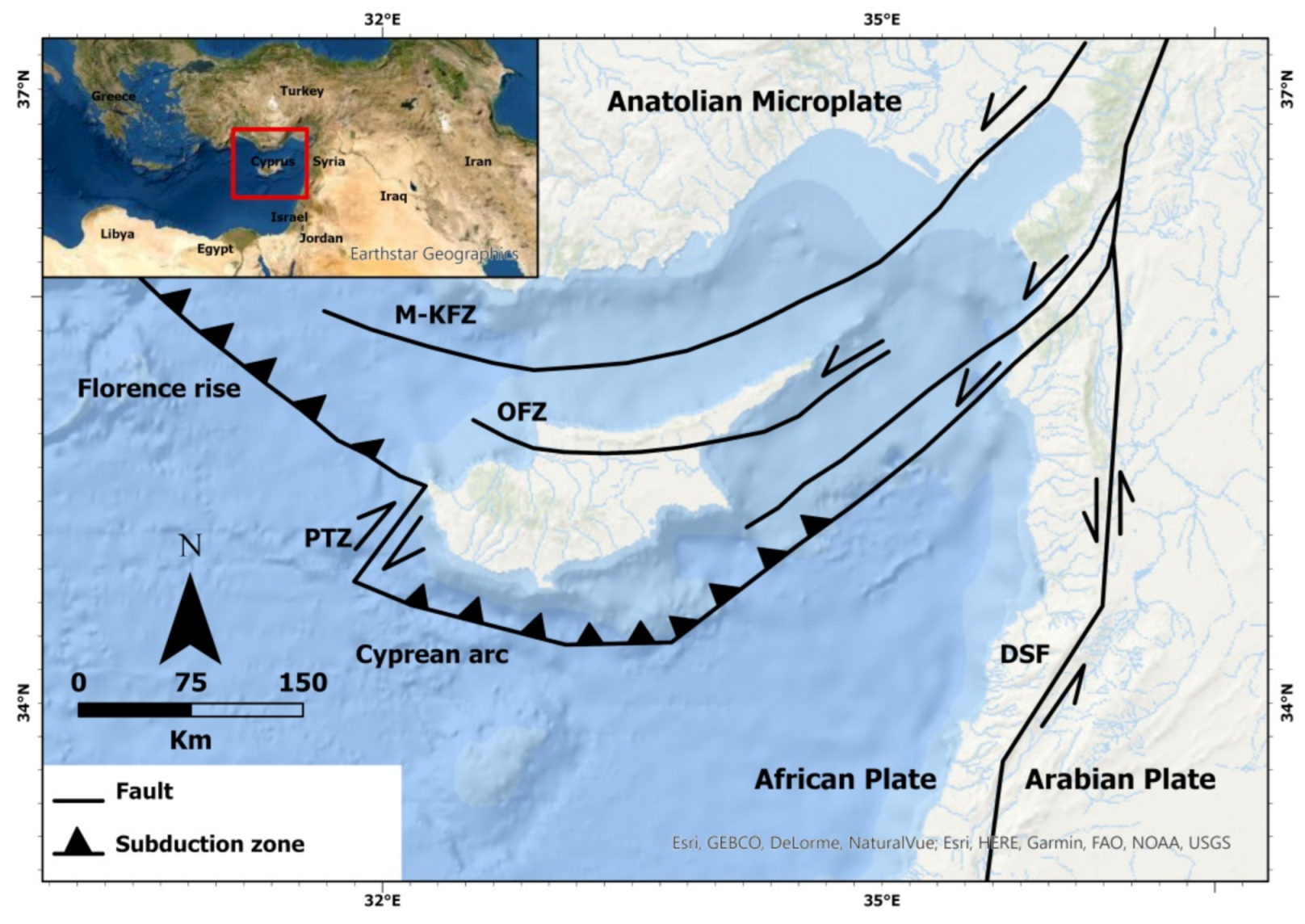
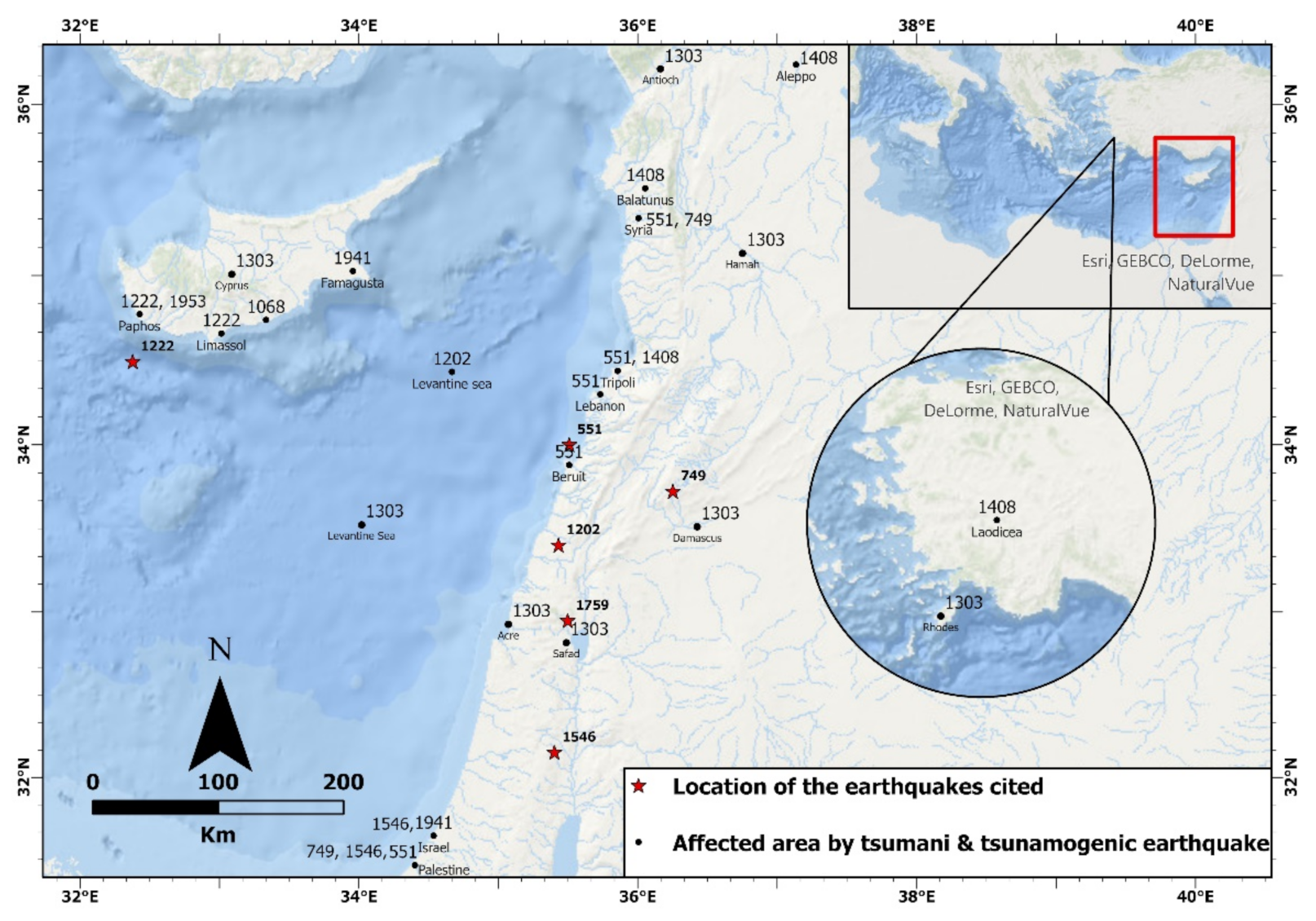

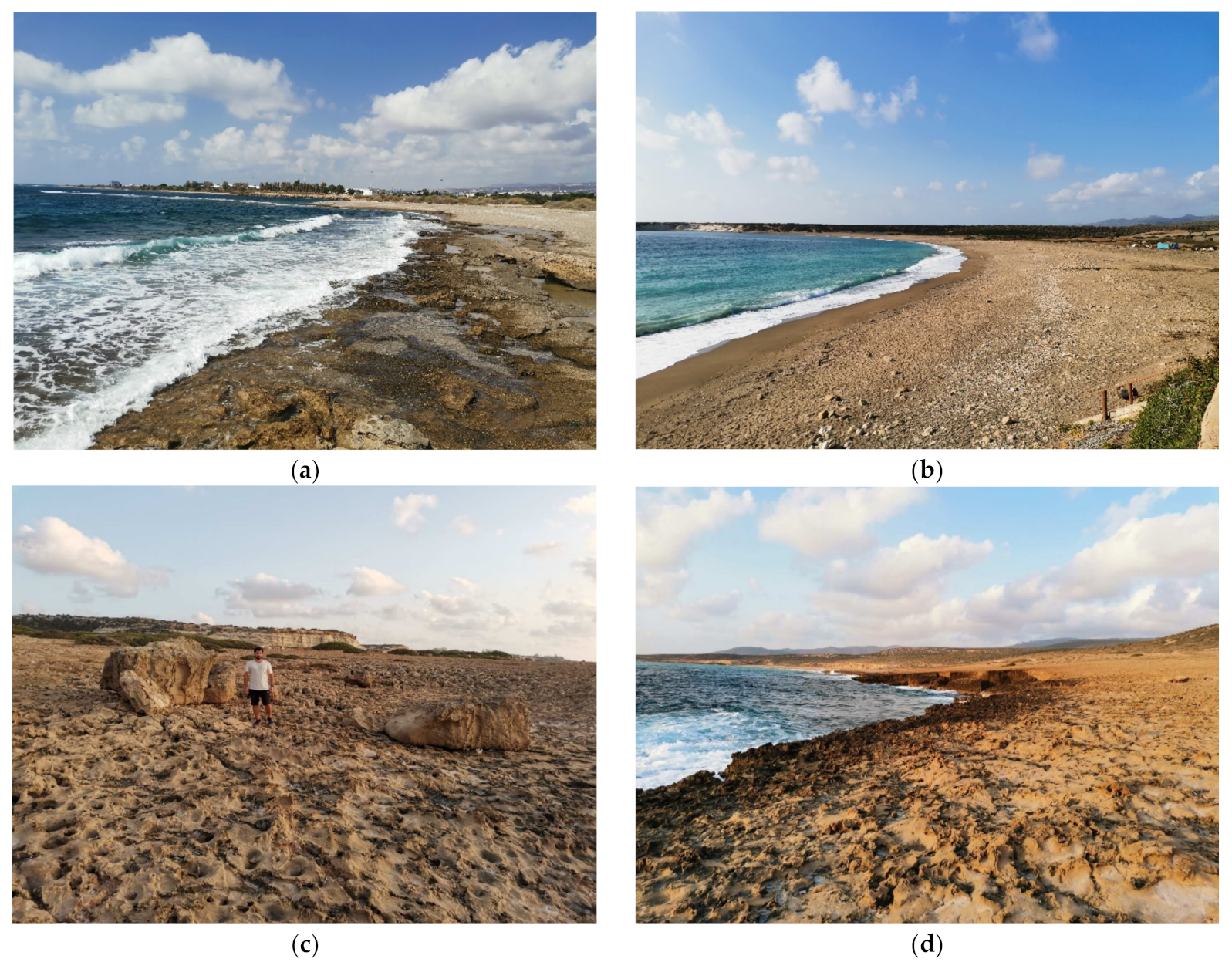
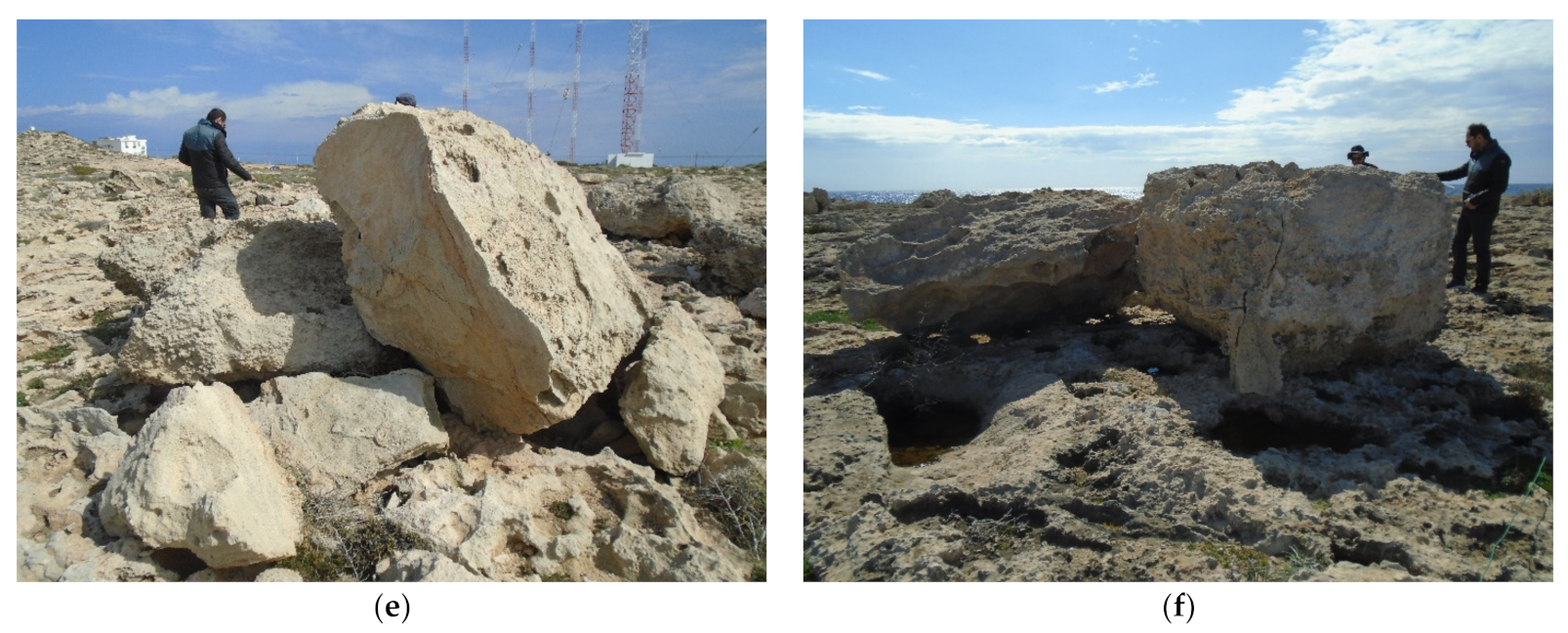
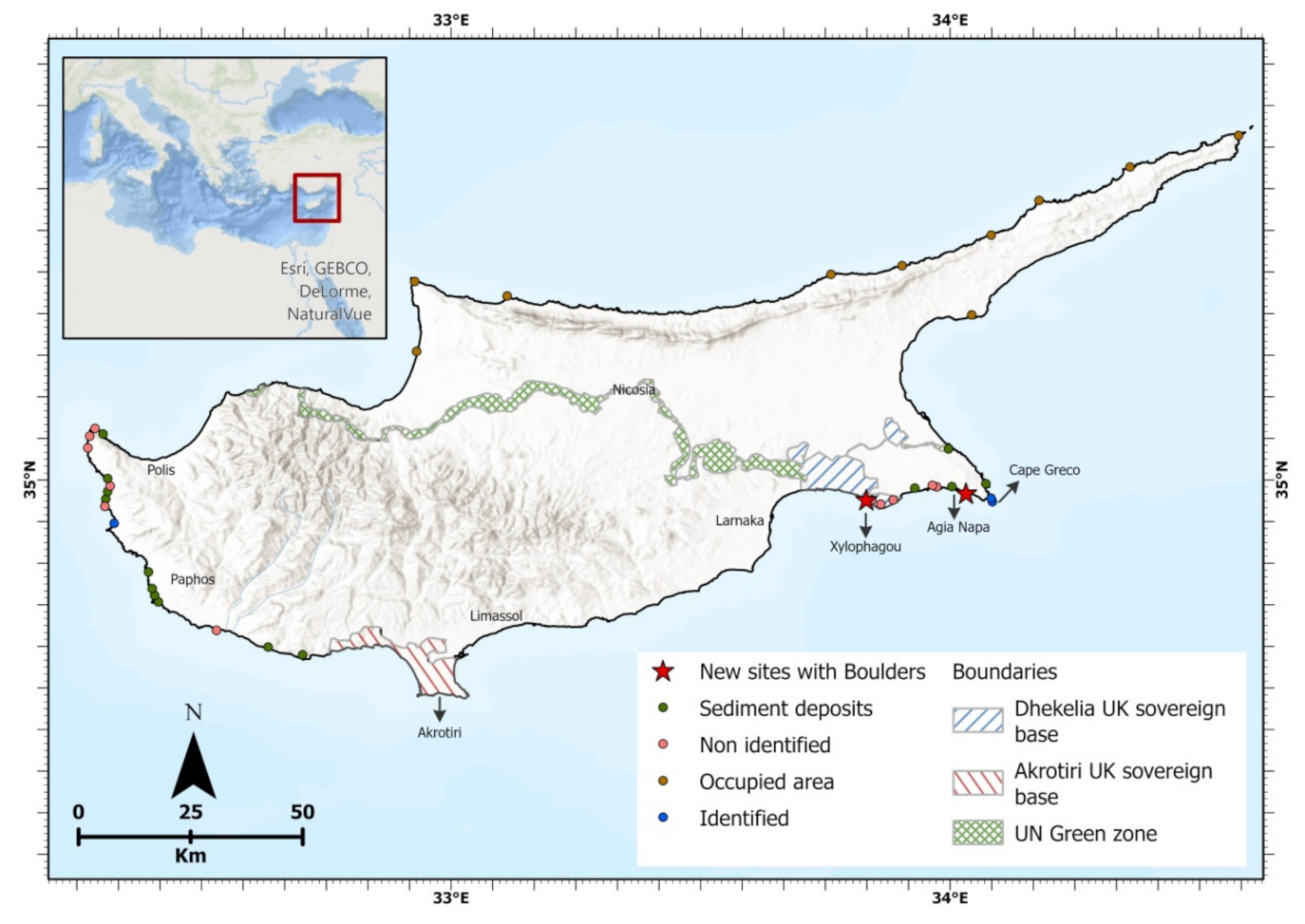

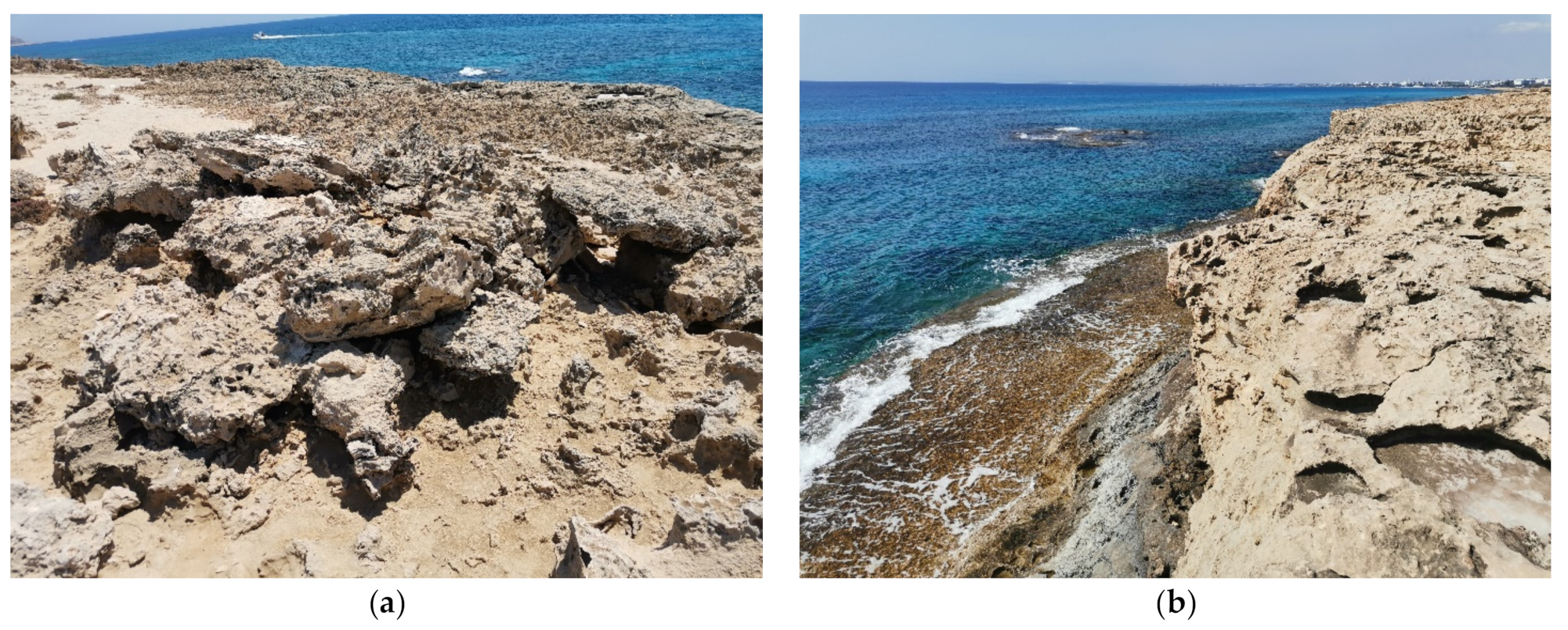
Publisher’s Note: MDPI stays neutral with regard to jurisdictional claims in published maps and institutional affiliations. |
© 2022 by the authors. Licensee MDPI, Basel, Switzerland. This article is an open access article distributed under the terms and conditions of the Creative Commons Attribution (CC BY) license (https://creativecommons.org/licenses/by/4.0/).
Share and Cite
Evelpidou, N.; Karkani, A.; Polidorou, M.; Saitis, G.; Zerefos, C.; Synolakis, C.; Repapis, C.; Tzouxanioti, M.; Gogou, M. Palaeo-Tsunami Events on the Coasts of Cyprus. Geosciences 2022, 12, 58. https://doi.org/10.3390/geosciences12020058
Evelpidou N, Karkani A, Polidorou M, Saitis G, Zerefos C, Synolakis C, Repapis C, Tzouxanioti M, Gogou M. Palaeo-Tsunami Events on the Coasts of Cyprus. Geosciences. 2022; 12(2):58. https://doi.org/10.3390/geosciences12020058
Chicago/Turabian StyleEvelpidou, Niki, Anna Karkani, Miltiadis Polidorou, Giannis Saitis, Christos Zerefos, Costas Synolakis, Christos Repapis, Maria Tzouxanioti, and Marilia Gogou. 2022. "Palaeo-Tsunami Events on the Coasts of Cyprus" Geosciences 12, no. 2: 58. https://doi.org/10.3390/geosciences12020058
APA StyleEvelpidou, N., Karkani, A., Polidorou, M., Saitis, G., Zerefos, C., Synolakis, C., Repapis, C., Tzouxanioti, M., & Gogou, M. (2022). Palaeo-Tsunami Events on the Coasts of Cyprus. Geosciences, 12(2), 58. https://doi.org/10.3390/geosciences12020058












